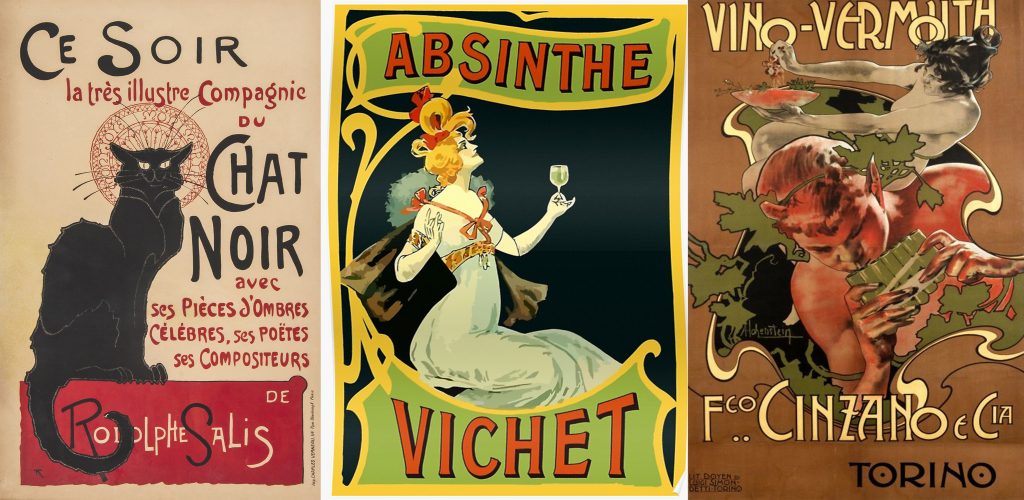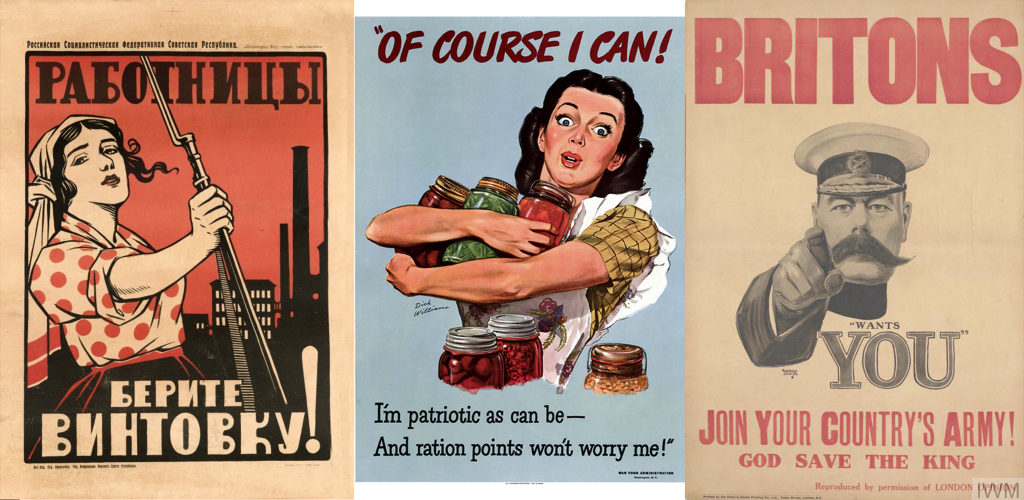History Of Poster Design Video
We take a look back on how the modern poster revolutionised the advertising world. Travelling back to 19th century France where the invention of the Lithograph made mass production possible, through to the 21st century and the digitisation of poster art. Poster artwork continues to be an iconic, evolving, and collectable medium.
1880-1895 – The Birth of the Lithographic Poster

Jules Cheret's '3 stone lithographic process' was introduced, whereby a mixture of three colours (usually red, yellow and blue) allowed a remarkable intensity of colour and texture to be printed.

Cheret has been called the father of the modern poster due to the high quality, vibrant designs his technique allowed and his own personal contributions – he created more than 1000 posters over a 30 year career.
Lithography works on the simple physical principle that oil and water do not mix. The desired image is placed on a plate which is then covered in ink. It takes great skill to make sure the inks are mixed correctly and placed in the right order. The Lithographic poster ushered in a new wave of modern advertising.
1890-1900 – The Belle Epoque & Art Nouveau

As the new technique allowed faster, mass productions of posters to take off, poster exhibitions, magazines and dealers proliferated.
As Cheret and some of the earlier litho designers moved on to painting, Alphonse Mucha – a Greek working in Paris, created the first masterpiece of Art Nouveau poster design. Characterised by its flowering, ornate style, this became the major international decorate art movement right up until the First World War.
Posters soon transformed the thoroughfares of Paris, making the streets into what one contemporary called "the poor man's picture gallery."
Roger Marx, Masters of the Poster, 1896–1900 (New York, 1977), p. 7.
1900-1914 – The New Century & Early Modernism

Italian caricaturist Leonetto Cappiello rises to fame, Capiello rejected the fussy, detailed Art Nouveau style. Opting for simple, bold images that were weird and funny in order to capture the attention of passers by. His strong brand identity and infamous design style heralded him as the father of modern advertising.
There was a shift in style towards functionalism, flat colours and shapes made works more modern in their visual language.
Max Gallo, The Poster in History, (2002) W.W. Norton
"For over two hundred years, posters have been displayed in public places all over the world. Visually striking, they have been designed to attract the attention of passers-by, making us aware of a political viewpoint, enticing us to attend specific events, or encouraging us to purchase a particular product or service."
1914 – 1919 – World War I & the Bolshevik Revolution

World War One saw the beginning of the poster as political propaganda. It was used to recruit soldiers, encourage donations, bolster morale and public efforts towards the war and highlight the evilness of the opposition.
America alone produced around 2,500 poster designs in just 2 years. Lenin's Russia, with Josef Goebell at the helm, became the pioneering masters of modern propaganda.
1919 – 1938 – Between the World Wars: Modernism & Art Deco

As society became increasingly industrialised, the style of posters also became so. Modern art movements like Dadaism, Futurism, Expressionism and Cubism became the new inspirations/ stimulations.
The first graphic designs courses were introduced, showing how much the art had become distinct from pure illustration / fine art. Constructivist art arose to create the new revolutionary, technological society.
The 'agitational' style featured strong diagonals, photomontage and more striking, macabre colour palettes.
This all started to bleed into Western designs, with Bauhaus becoming a movement in itself.

By the mid twenties, these styles formed together into Art Deco – a derivative of the 1925 Decorative Arts Exposition in Paris. Shapes became streamlined, typography became linear and reflective of the roaring jazz age. Images of machinery with an airbrushed finish were popular.
1938 – 1950 – World War II & the End of Stone Lithography

Poster design in World War 2 again played a large role in communicating the war efforts, however, it did not have as larger tractions as in the first, as other forms of media such as radio – and later television began to take over.

The mass production of posters using the photo offset technique made it possible for photography to be included. This effect – which is still used in newspapers and characterised by half tone dots.
1945 – 1965 – Post-World War II & Mid-Century Modernism
The age of the baby boomer – new consumer society – TV, jet travel and global brands.
The 1950's saw a 'poster boom' giving rise to two main distinct styles – consumer and corporate.

The consumer or '50's style' was characterised by vivid, bright colours, playful motifs and whimsicality. The corporate / 'International Typographic style' or 'Swiss' style was ordered, highly structured and systematic in it's design.

1965 – 1972 – The Sixties & the Art of Rebellion

After the systematic definitions of style in the 50's, the 60's did a 180 and went to the other extreme. Surrealist, psychedelic prints in 'groovy' fat, splurging fonts became all the rage. Pop Art, and pulsating afterimages of Op-Art in rainbow colours came to define the period.
"Aposter is a temporary promotion of an idea, product, or event put up in a public space for mass consumption."
1970 – 1989 – The Seventies & Eighties – Postmodernism

Postmodernism is now the predominant style. During this period it was Wolfgang Weingart who was most influential. He experimented to produce complex, chaotic, playful, spontaneous designs that disregarded all his formal training.
Weingarts liberation of typography was an important foundation for several new styles, Memphis & Retro, to the advances being made in computer graphics.
The Modern Day

Now, poster design is evolving even more as computer design programmes (such as Adobe Creative Suite) get more and more advanced. All past styles are referenced and usually merged together to create new sub-genres of design. Digitisation of advertising boards is also making it possible for moving images to be incorporated into designs. To this day, the out of home poster advertising medium is still the most successful and powerful.
Posters are iconic, especially for advertising events and gigs. If advertising popular artists, the posters themselves become collectors items.
At Pop Art we have full in house printing facilities and over 200 sites on which you can advertise your event poster! We can even create the artwork for you. Get in touch today to discuss a custom designed campaign for you.
History Of Poster Design Video
Source: https://popartmediagroup.co.uk/a-brief-history-of-the-modern-poster/
Posted by: craighatiagoorah.blogspot.com

0 Response to "History Of Poster Design Video"
Post a Comment